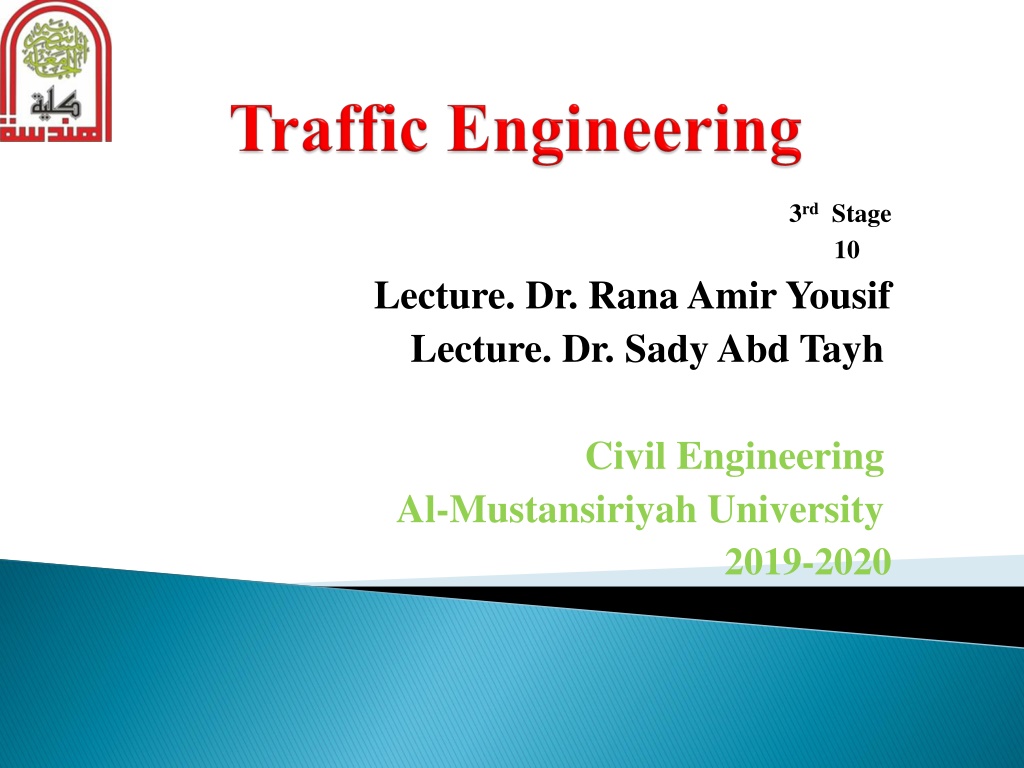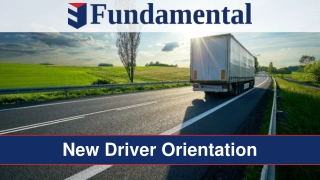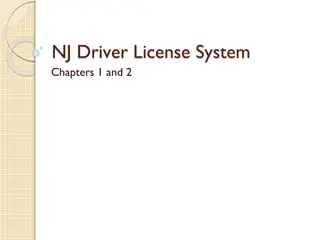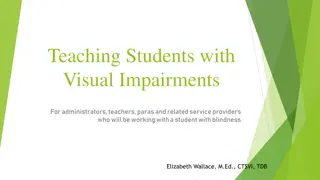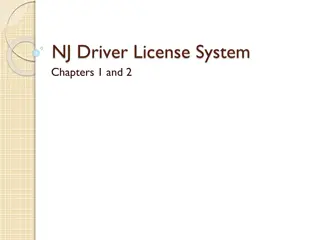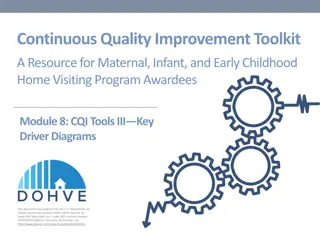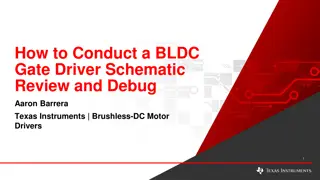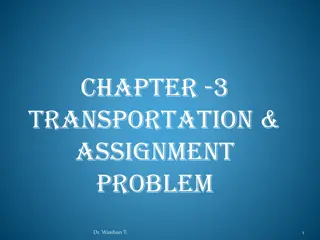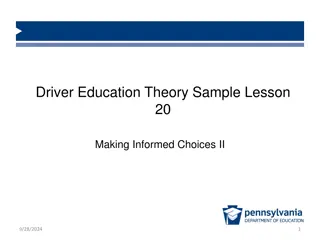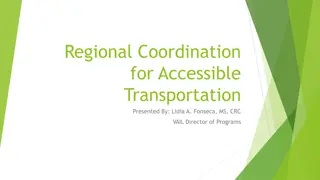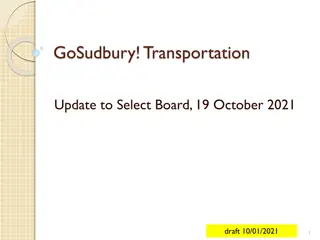Driver Characteristics and Visual Acuity in Transportation Engineering
The course content focuses on the importance of considering driver characteristics, such as sensory perceptions and visual acuity, in transportation design. It discusses how drivers sense information through feeling, seeing, hearing, and smelling, emphasizing the role of visual acuity aspects like static/dynamic vision, peripheral vision, depth perception, and more. Factors affecting visual acuity, like age and speed, are also highlighted to underscore their impact on driver safety and highway design.
Download Presentation

Please find below an Image/Link to download the presentation.
The content on the website is provided AS IS for your information and personal use only. It may not be sold, licensed, or shared on other websites without obtaining consent from the author. Download presentation by click this link. If you encounter any issues during the download, it is possible that the publisher has removed the file from their server.
E N D
Presentation Transcript
3rdStage 10 Lecture. Dr. RanaAmir Yousif Lecture. Dr. SadyAbd Tayh Civil Engineering Al-Mustansiriyah University 2019-2020
References: Nicholas J. Garber and Lester A. Hoel. Traffic and Highway Engineering , Fourth Edition. Yoder; E. J. and M. W. Witczak, Principles of Pavement Design , A Wiley- Interscience Publication, John Wiley & Sons Inc., U.S.A., 1975. Yaug H. Huang, Pavement Analysis and Design , Prentic Hall Inc., U.S.A., 1993. AASHTO Guide for Design of Pavement Structures 1993 , AASHTO, American Association of State Highway and Transportation Officials, U.S.A., 1993. Oglesby Clarkson H., Highway Engineering , John Wiley & Sons Inc., U.S.A., 1975.
One transportation engineers when they consider driver characteristics in the course of design in the varying skills and perceptual abilities of drivers on highway. This is demonstrated by the wide range of people s abilities to hear, see and react to information. of the problem that facts traffic and Driver personality: the driver personality is a broad- based body of knowledge that deals with the driver s natural abilities, learned capabilities, and the natives and attitudes.
a) Sences: information through feeling, seeing, hearing and smelling. Feeling: a driver experiences forces acting on a vehicle, such as the force gravity , acceleration, barking deceleration and corner acceleration. Seeing: is the most important means of acquiring accurate information. the driver can receive useful
Certain characteristics of visual acuity are of special interest in transportation. 1. Static and dynamic. 2. Peripheral vision. 3. D-visual sensitivity. 4. Depth perception. 5. Glare recovery and night vision.
Is the ability to see fine details clearly, the most acquit vision is within 3 to 5 and fairly to (10-12) degree clear. Age affect on visual acuity. (3-5) to (10-12) Visual fields to drivers
2. Personal vision: ability of people to see object beyond the cone of clear vision. Although object can be seen within this zone, details and color are not clear. Angle of peripheral vision varies between (120-180) degree. Speed affects on the peripheral vision. 25mph 45mph 60 mph 100 <40 65 Distance of visual field to drivers (m)
3. Depth perception: ability of person to estimate speed and distance , it is important in two-lane highway during judging passing maneuvers , where accidents results from lack of proper judgment of speed and distance. 4. d- sensitivity to colors: it is estimated about 8% of all men and 4% of all women suffer from some degree of color blindness (reduce the ability to distinguish between red and green). 5. Glare recovery and night vision: glare from approaching headlights greatly reduces visibility. Night been shown greater negative impacts with increasing age.
Hearing is an important to driver and pedestrian. Although usually not as important vision in the act of driving. Hearing can helpful in preventing collision. The sense of smell is useful to driver in detecting such emergencies as an overheated engine , burning breaks, smoking exhausts, and fires.
b) Mind: Intelligence: High level not necessary or especially helpful in taking the right decision and is different from one driver to another. c) Bones and Muscles: by which the driver directs and controls his vehicles. Stature to fit vehicles and its controls. Strength to operate controls.
Knowledge or information: gained by reading, instruction and by quizzing. Skill and habits: gained by practice. How the driver think and feel about many things often lead him to drive unsafely even ha can know how to drive well.
Motives: makes a driver try to drive well as he can and knows how to. It is associated with fair of injury and feeling of social responsibility. Attitudes: determine how a driver reacts to a driving situation. Playing games with other car. Racing. Showing off.
Which include the following: Fatigue. Drugs, alcohol. Illnesses. Comfort. Time of day, temperature , noise.
Pedestrian characteristics affect on the design and location of pedestrian control device. Such control device include special pedestrian signals, and crosswalks, safety zones and islands at intersection. Walking characteristics play a major part in the design of some of these controls. Observation on pedestrian movements have indicated the walk speed vary for male and female. 4.93 ft/sec. male. 4.63 ft/sec. Female. The MUTCD suggest use 4 ft/sec. for design purpose.
Vehicle characteristics , which include such details as size and weight of vehicles. Design vehicles: is the vehicle selected to represent all vehicles on the highway. Its weight, dimensions and operating characteristics.
the gross weight, size, length of the vehicles is an important factor in the determination of design standards for several physical components of highway. These include lane width, shoulder width, length and width of parking bays, and lengths of vertical curves. The axle weights of all vehicles are important when pavement depths and maximum grades are being determined. The single-unite truck(SU): represents all single unit truck and small buses. The single-unite bus (BSU): represents transit buses with length (40ft).
the primary element among kinematic characteristics is the acceleration capability of the vehicle. It is important in passing maneuvers and gap acceptance, also the dimensioning of highway features such as freeway ramps and passing lanes is often governed by acceleration. The fundamental relationship connecting force and acceleration is given by the equation: F=m*a Where: F: force. m:mass. a: acceleration.
Acceleration is assumed constant 1. ----------1 ----------2 ----------3 Where:
Non- uniform acceleration 2. ----------1 ----------2 Where: and are constant. ----------3 ----------4
A truck traveling at 25 mph is approaching a stop sign. At time to and a distance of 60ft the truck begins to slow down by decelerating at 14ft/sec2. will the truck be able to stop in time? Solution: V : final Velocity = 0 ft/sec. : 25 mph =36.67 ft/sec. 0 = 36.67 14 t t = 2.62 sec.
the distance covered by truck in these 2.62 sec. is: = 48.02 ft< 60 ft This is indicates that the truck will stop just in time.
